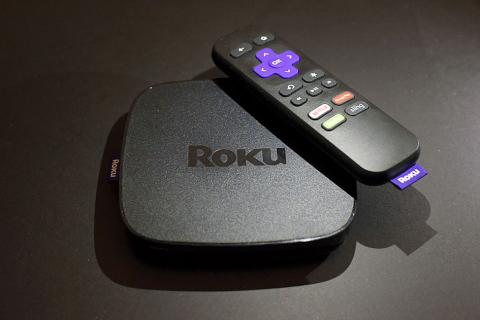Online streaming television pioneer Roku Inc on Friday filed paperwork to raise as much as US$100 million with an offering of stock on the NASDAQ exchange.
Roku was early to the trend of viewers “cutting the cord” and shunning traditional cable television in favor of streaming shows online as desired.
The first-generation Roku streamed Netflix, but its “set-top boxes” have evolved to offer content from an array of providers including Hulu and HBO Now.

Photo: AP
Roku said its branded devices for tapping into the company’s video streaming platform are sold in the UK, Canada, France, Ireland, Mexico and the US.
The Roku app is available more broadly.
Some television makers have built Roku software directly into display screens. Content offerings include subscriptions and shows supported by ads.
Roku and Netflix Inc both have their main offices in the Silicon Valley city of Los Gatos, California.
Roku said in a filing with the US Securities and Exchange Commission that it intended to be traded as ROKU, but did not set a share price.
There were 15.1 million active Roku accounts at the end of June, and users of the service streamed more than 6.7 billion hours of video in the first six months of the year, the company said in the filing.
Roku is the top television streaming platform in the US as measured by total hours streamed.
Roku reported revenue of US$199.7 million in the first half of this year, an increase of 23 percent from the same period last year.
Meanwhile, the company’s net loss shrank to US$24.2 million in the six months which ended on June 30 from US$33.2 million during the same period last year.
“Our mission is to be the TV streaming platform that connects the entire TV ecosystem,” Roku founder and chief executive Anthony Wood said in a letter included in the filing.
“I believe that just like mainframeoperating systems didn’t transition to PCs, and just like PC operating systems didn’t make the transition to phones (is your phone powered by Windows?), TVs will be powered by a purpose-built operating system optimized for streaming,” he added.

Taiwanese suppliers to Taiwan Semiconductor Manufacturing Co. (TSMC, 台積電) are expected to follow the contract chipmaker’s step to invest in the US, but their relocation may be seven to eight years away, Minister of Economic Affairs J.W. Kuo (郭智輝) said yesterday. When asked by opposition Chinese Nationalist Party (KMT) Legislator Niu Hsu-ting (牛煦庭) in the legislature about growing concerns that TSMC’s huge investments in the US will prompt its suppliers to follow suit, Kuo said based on the chipmaker’s current limited production volume, it is unlikely to lead its supply chain to go there for now. “Unless TSMC completes its planned six

Power supply and electronic components maker Delta Electronics Inc (台達電) yesterday said second-quarter revenue is expected to surpass the first quarter, which rose 30 percent year-on-year to NT$118.92 billion (US$3.71 billion). Revenue this quarter is likely to grow, as US clients have front-loaded orders ahead of US President Donald Trump’s planned tariffs on Taiwanese goods, Delta chairman Ping Cheng (鄭平) said at an earnings conference in Taipei, referring to the 90-day pause in tariff implementation Trump announced on April 9. While situations in the third and fourth quarters remain unclear, “We will not halt our long-term deployments and do not plan to

‘SHORT TERM’: The local currency would likely remain strong in the near term, driven by anticipated US trade pressure, capital inflows and expectations of a US Fed rate cut The US dollar is expected to fall below NT$30 in the near term, as traders anticipate increased pressure from Washington for Taiwan to allow the New Taiwan dollar to appreciate, Cathay United Bank (國泰世華銀行) chief economist Lin Chi-chao (林啟超) said. Following a sharp drop in the greenback against the NT dollar on Friday, Lin told the Central News Agency that the local currency is likely to remain strong in the short term, driven in part by market psychology surrounding anticipated US policy pressure. On Friday, the US dollar fell NT$0.953, or 3.07 percent, closing at NT$31.064 — its lowest level since Jan.

The New Taiwan dollar and Taiwanese stocks surged on signs that trade tensions between the world’s top two economies might start easing and as US tech earnings boosted the outlook of the nation’s semiconductor exports. The NT dollar strengthened as much as 3.8 percent versus the US dollar to 30.815, the biggest intraday gain since January 2011, closing at NT$31.064. The benchmark TAIEX jumped 2.73 percent to outperform the region’s equity gauges. Outlook for global trade improved after China said it is assessing possible trade talks with the US, providing a boost for the nation’s currency and shares. As the NT dollar